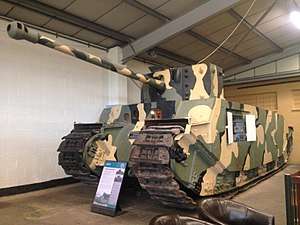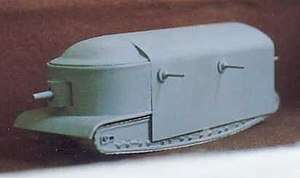Super-heavy tank
Super-heavy tank, also super heavy tank, is any tank that is notably beyond the standard of the class heavy tank in either size or weight relative to contemporary vehicles.

History
Programs have been initiated on several occasions with the aim of creating an indestructible vehicle for penetrating enemy formations without fear of being destroyed in combat; however, only a few examples have ever been built, and there is little evidence of any super heavy tank having seen combat. Examples were designed in World War I and World War II, along with a few in the Cold War.
World War I period

The first super-heavy tank was designed by the Russian naval engineer Vasily Mendeleyev who worked on the project from 1911 to 1915. The tank was envisioned to be invulnerable to almost all contemporary threats but remained on paper because of its high construction cost.[1][2] Following the production of their first tanks, the British "Flying Elephant" was designed as a tank that would be resistant to artillery fire. Since mobility was more important than protection, and the tanks already developed were successful, work on the project was stopped. The German K-Wagen (Großkampfwagen) was a very heavy design carrying 4 guns and needing a crew of 27. Two of them were under construction when the war ended and both were demolished.
In the early 1920s, the French produced the 70-tonne Char 2C. The ten tanks would see limited combat during the Battle for France in 1940.
World War II period
During World War II all of the major combatants introduced prototypes for special roles. Adolf Hitler was a proponent of "war winning" weapons and supported projects like the 188 tonne Maus, and even larger 1,000 tonne Landkreuzer P. 1000 Ratte. The British and Soviets all built prototype designs similar to the Jagdtiger, and the US was working on the project then known as T95 Gun Carriage, which was later changed to T28 Super Heavy Tank. However, most of these designs never passed the prototype stage, and only some have ever been in existence.
Cold War period
The idea of very heavy tanks saw less development after the war, not least since tactical nuclear weapons would always be more powerful than any feasible armour could protect against. The advances in armour technology allowed large tanks to stay in the approximate up to 65 ton range. Examples include Object 279 (Soviet Union) and T30 Heavy Tank (United States).
Post Cold war
Further advances in armour technology have given the armour of late 20th century tanks the estimated equivalent of over a meter of rolled homogeneous armour (the type of armour used before, now used for comparison between different armour designs). At the same time the weapon development allows for any equal adversary to destroy any target detected and tracked by the wide array of different sensors available. This means adding more armour would not increase protection to any significant degree, and thus current development is instead focused on a combination of remaining undetected, interfering with tracking and active counter-measures to neutralize the enemy weapon systems.
List of super-heavy tanks
- United Kingdom
- TOG1 – 80 tons; built in 1940; designed for ground conditions similar to those experienced in WWI; one prototype.
- TOG2 – 80 tons improved design of TOG1; one prototype.
- Flying Elephant – First World War-era project at 100 tons; not built.
- Tortoise heavy assault tank – 80 tons, designed to attack fortifications. 6 pilot vehicles completed.
- Neither of the TOG prototypes were built the way they were designed; had the sponsons been added, and the proper turret attached, their weight would be different.
- France
- Char 2C – 69 tons; World War I era technology; 10 built, in service from 1921 to 1940; obsolete by World War II, 9 destroyed to prevent capture and the remaining 1 was shown in Berlin as a trophy.
- Char 2C bis - 72 tons; modified Char 2C with 155 mm howitzer and different turret; one Char 2C was converted into this variant but later returned into the original configuration
- FCM F1 – 139 tons; World War II era replacement for the Char 2C, to attack fortifications. Ordered and full-scale wooden mock-up was produced but no prototype built before the Fall of France (1940).
- ARL tracteur C - 145 tons, developed by ARL to attack fortifications; wooden mockup was produced but canceled in favor of FCM F1 which was proven to be superior design (developed 1939-1940)
- AMX tracteur C - 140 tons, developed by AMX to attack fortifications; the project was terminated after AMX being horribly out of schedule (developed 1939-1940)
- Nazi Germany
- Jagdtiger – 71.7 tons. 70-88 built
- Panzer VII Löwe – About 95–100 tons; canceled in favour of Maus.
- Panzer VIII Maus – 188 tons, two prototypes. Both were captured by the Soviet army, although one had been partially destroyed. A composite of the two can now be seen at the Kubinka Tank Museum.
- Panzerkampfwagen E-100 – 140 tons; one incomplete hull at factory captured by British and later scrapped.
- Panzer IX – Concept by Signal.
- Panzer X – Another concept by Signal.
- Landkreuzer P. 1000 Ratte – 1,000 tons; canceled, no evidence construction began.
- Japanese Empire
- O-I series
- Soviet Union
- T-42 (Tank Grote or TG-V) – 100 tons with 107 mm main gun and four sub-turrets. Models and drawings produced [5]
- KV-4 – 1941 project. A proposed 90–100 ton tank, carrying a 107 mm main gun and a 45 mm or 76 mm secondary; various layouts were considered, with the hull-mounted 107 mm and a 76 mm turret chosen as the final option.[6] Feasibility stage only.
- KV-5 – another Kliment Voroshilov series 100-ton-class tank design. Armed with the same 107 mm main gun in a large, KV-2-style turret, and two 12.7 mm machine gun turrets (one on the forward hull, one on top of the main turret); powered by two V2 diesels due to wartime lack of a 1200 hp engine. Project stopped due to Siege of Leningrad and cancelled without anything built.
- Note. KV-VI is just a hoax tank, the closest to it in name was the KV-6, which was not a super-heavy tank, which functioned as a KV-1 armed with a flamethrower.
- Russian Empire
- Tsar Tank – A giant-wheeled gun platform of 1914 which was abandoned because it was vulnerable to artillery.
- Mendeleev Tank - A massive super-heavy tank designed in 1911-1915, it weighed approximately 173.2 tons.
- German Empire
- K-Wagen – 120 metric tons; two were nearly complete when World War I ended. Both were demolished.
- United States
- T28 Super Heavy Tank – Also known as T95 GMC, designed for attacking heavy fortifications. 86.2 metric tons; 2 prototypes built right after World War II; by layout a self-propelled gun. Very similar to British Tortoise. One can now be seen on display at Fort Benning, Georgia.
See also
- Landship
- Heavy tank
- Bolo (tank)
References
- Svirin, Mikhail (2009). Танковая мощь СССР [Tank Power of the USSR] (in Russian). Moscow: Yauza, Eksmo. pp. 15–17. ISBN 978-5-699-31700-4.
- Kholyavsky, Gennady (1998). Энциклопедия танков [Encyclopedia of Tanks] (in Russian). Minsk: Kharvest. p. 25. ISBN 985-13-8603-0.
- Taki’s Imperial Japanese Army page: Super-Heavy Tank "O-I"
- Estes 2014, p. 37.
- Zaloga 1984:85
- KV-4 data sheet and pictures of the proposed designs
Bibliography
- Estes, Kenneth (2014). Super-heavy Tanks of World War II. Osprey. ISBN 978-1782003830.CS1 maint: ref=harv (link)
- Zaloga, Steven J., James Grandsen (1984). Soviet Tanks and Combat Vehicles of World War Two, London: Arms and Armour Press. ISBN 0-85368-606-8.